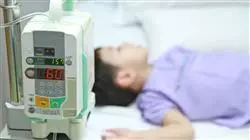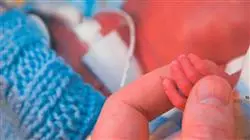University certificate
The world's largest faculty of medicine”
Why study at TECH?
The new scenarios in approaching pediatric emergencies motivated us to propose new specialization programs that meet the real needs of experienced professionals, so that they can incorporate advances in clinical practice for critically ill children"

Like other medical specialties and subspecialties, pediatric emergencies have reached a development of progressive specialization in recent years. Physicians working in pediatric emergency care services must be able to provide comprehensive initial care to pediatric patients, basing their actions on the latest scientific evidence.
For this reason knowledge must be constantly updated through programs aimed at reinforcing their functions, both in recognizing and initially resolving the emergency, and in focusing, orienting and correctly directing situations in the face of pathologies that can be delayed.
The specialization of the pediatric emergency department physician should include the updating of diagnostic and therapeutic techniques as airway management, peripheral and central line approach or immobilization of trauma and patients, to ensure rapid and safe care in all pediatric ages. In addition, it should include organizational aspects of pediatric emergency services and the provision of personnel and material, with emphasis on their differential characteristics.
This program offers physicians updated training on the most important Pediatric Emergencies, establishing the keys for critically ill patient care, and the approach to the different diagnostic and treatment techniques of emergency care in the pediatric age.
Scientific evidence increases the quality of medical care. Keeping up to date is key to providing better care to critically ill pediatric patients”
This Postgraduate diploma in Critical Pediatric Patients is the most complete and up-to-date scientific program on the market. The most important features of the program include:
- Clinical cases presented by experts. Graphic, schematic and eminently practical contents, with which they are conceived, gather scientific and assistance information on medical disciplines that are essential for professional practice
- Latest diagnostic and therapeutic developments in the most frequent pediatric emergencies; it also incorporates new contents: emergency electrocardiography, sedoanalgesia in emergencies, etc
- Practical workshops on procedures, diagnostic and therapeutic techniques
- Algorithm-based interactive learning system for decision-making in the presented clinical situations
- Theoretical lessons, questions to the expert, debate forums on controversial topics, and individual reflection assignments
- Content that is accessible from any fixed or portable device with an Internet connection
This Postgraduate diploma may be the best investment you can make when choosing a refresher program for two reasons: in addition to updating your knowledge of critical pediatric patient care, you will obtain a qualification TECH Global University”
Its teaching staff includes leading physicians, who bring to this specialization the experience of their work, as well as other who specialize in the various fields of emergency medical care.
The multimedia content developed with the latest educational technology will provide the professional with situated and contextual learning, i.e., a simulated environment that will provide an immersive training program to train in real situations.
This program is designed around Problem Based Learning, whereby the physician must try to solve the different professional practice situations that arise during the course. For this reason, you will be assisted by an innovative, interactive video system created by renowned and experienced experts in pediatric emergencies with extensive teaching experience.
Increase your decision-making confidence by updating your knowledge in treating Critical Pediatric Patients with this Postgraduate diploma"

This program offers training in simulated environments, which provides an immersive learning experience designed to train for real-life situations"
Syllabus
The content structure has been designed by a team of professionals who recognize the implications of specialization in good medical practice in the pediatric emergency department, are aware of the current relevance of training to be able to treat critical pediatric patients, and are committed to quality teaching through new educational technologies.

This Postgraduate diploma in Critical Pediatric Patients is the most complete and up-to-date scientific program on the market”
Module 1. Health Care Organization for Pediatric Emergencies
1.1. Equipment in the Pediatric Emergency Department (PED)
1.1.1. Differential Characteristics of PEDs
1.1.2. Infrastructure, Staffing
1.1.3. Material
1.2. Triage in Pediatrics
1.2.1. Definition
1.2.2. Classification Systems
1.3. Transport of Critical Pediatric Patient
1.3.1. Out-of-hospital Transfer
1.3.2. Neonatal and Pediatric Transportation
Module 2. Advanced Pediatric and Neonatal Cardiovascular Support
2.1. Apparently Lethal Syndromes
2.1.1. Sudden Infant Death
2.1.2. Treatment
2.1.3. Home Monitoring
2.2. Recognition and Management of Critically Ill Children
2.2.1. Epidemiology, Etiology and Prevention of CRP in Childhood
2.2.2. Pediatric Assessment Triangle (PAT) and Its Utility
2.2.3. Pediatric ABCDE Evaluation
2.3. Basic Pediatric Cardiopulmonary Resuscitation
2.4. Advanced Pediatric Cardiopulmonary Resuscitation Advanced Airway Management
2.5. Basic Concepts of Mechanical Ventilation
2.6. Infusion Routes and Drugs
2.7. Pediatric VAS Algorithms and Arrhythmia Treatment
2.8. Neonatal Resuscitation
2.9. Post-resuscitation Stabilization and Neonatal Transport
Module 3. Invasive Techniques in Critically Ill Pediatric Patients
3.1. Peripheral and Central Vein Access
3.1.1. Peripheral Route
3.1.2. Central Route
3.2. Intraosseous Puncture
3.3. Capnography Pulse Oximetry
3.4. Oxygen Therapy
3.5. Analgesia and Sedation
3.5.1. Approaching Pain
3.5.2. Procedure
3.5.3. Reference Drugs in Analgesia and Sedation
3.6. Protocol for Child Death
3.7. Rapid Intubation Sequence
Module 4. Cardiologic Emergencies
4.1. Arrhythmias and Syncope
4.1.1. Bradyarrhythmias Diagnosis and Treatment
4.1.2. Tachyarrhythmias Diagnosis and Treatment
4.2. Congenital Heart Disease
4.2.1. Cyanotic Congenital Heart Disease
4.2.2. Non-Cyanotic Congenital Heart Disease
4.2.3. Diagnostic Approach
4.2.4. Treatment
4.3. Hypertensive Crisis
4.3.1. Diagnostic Guidance for Hypertension in Children and Adolescents
4.3.2. Therapeutic Guidance for Hypertension in Children and Adolescents
4.4. Heart Failure
4.4.1. Etiology
4.4.2. Diagnosis
4.4.3. Treatment. Mechanical Ventricular Assistance Techniques Extracorporeal Membrane Oxygenation (ECMO)
Techniques and Procedures
4.5. Quick Reading of an ECG
4.6. Management of Tachyarrhythmias and Bradyarrhythmias: Electrical Cardioversion and Transcutaneous Pacing
4.7. Cardioversion and Temporary Pacemaker
4.8. Management of Defibrillable Arrhythmias: Defibrillation
4.9. Defibrillation

A unique, key, and decisive master’s degree experience to boost your professional development”
Postgraduate Diploma in Critical Pediatric Patients
A child is in critical condition when his or her life is at risk because one or more vital organs are affected or malfunction as a result of a serious illness or accident. Thus, a medical intervention or the sudden worsening of a chronic pathology can also lead to a malfunction of these organs. In such situations, urgent treatment is necessary in a highly specialized medical setting, such as a Pediatric Intensive Care unit with advanced diagnostic and therapeutic facilities. In fact, this Postgraduate Diploma in Critical Pediatric Patients provides the opportunity to delve into all these aspects
.
Advanced management of the most innovative invasive techniques to treat Critical Pediatric Patients
This Postgraduate Diploma in Critical Pediatric Patients will allow you to explore in an advanced way the health organization in the face of common Pediatric Emergencies, pediatric and neonatal cardiovascular support, the latest most effective invasive techniques or the different Cardiological Emergencies. All this from a comfortable online methodology and through an academic journey condensed in 425 hours in which you will be the one who organizes the study sessions. In addition, you will benefit from the fact of having Relearning as a methodological substrate to internalize all the concepts more quickly.







